Wilshire Grand, The Grand Pour, USA
Jan 29, 20
Wilshire Grand, The Grand Pour, USA
GUINNESS WORLD RECORDS for Largest Continuous Concrete Pour Kicks off Construction of Tallest Structure West of the Mississippi
It’s a project that kicked off in February 2014 with the largest continuous concrete pour as determined by GUINNESS WORLD RECORDS. Since then, the mixed-use Wilshire Grand project in downtown Los Angeles, owned by Korean Air Lines Co., Ltd. (Korean Air), has been progressing vertically with the help of two Putzmeister BSA 14000 Trailer Pumps, four Putzmeister MX 34/38Z Placing Booms and one Putzmeister Placing Boom Tower. After more than two years of work, the project has ‘topped out’ its concrete and steel core at more than 800 feet.
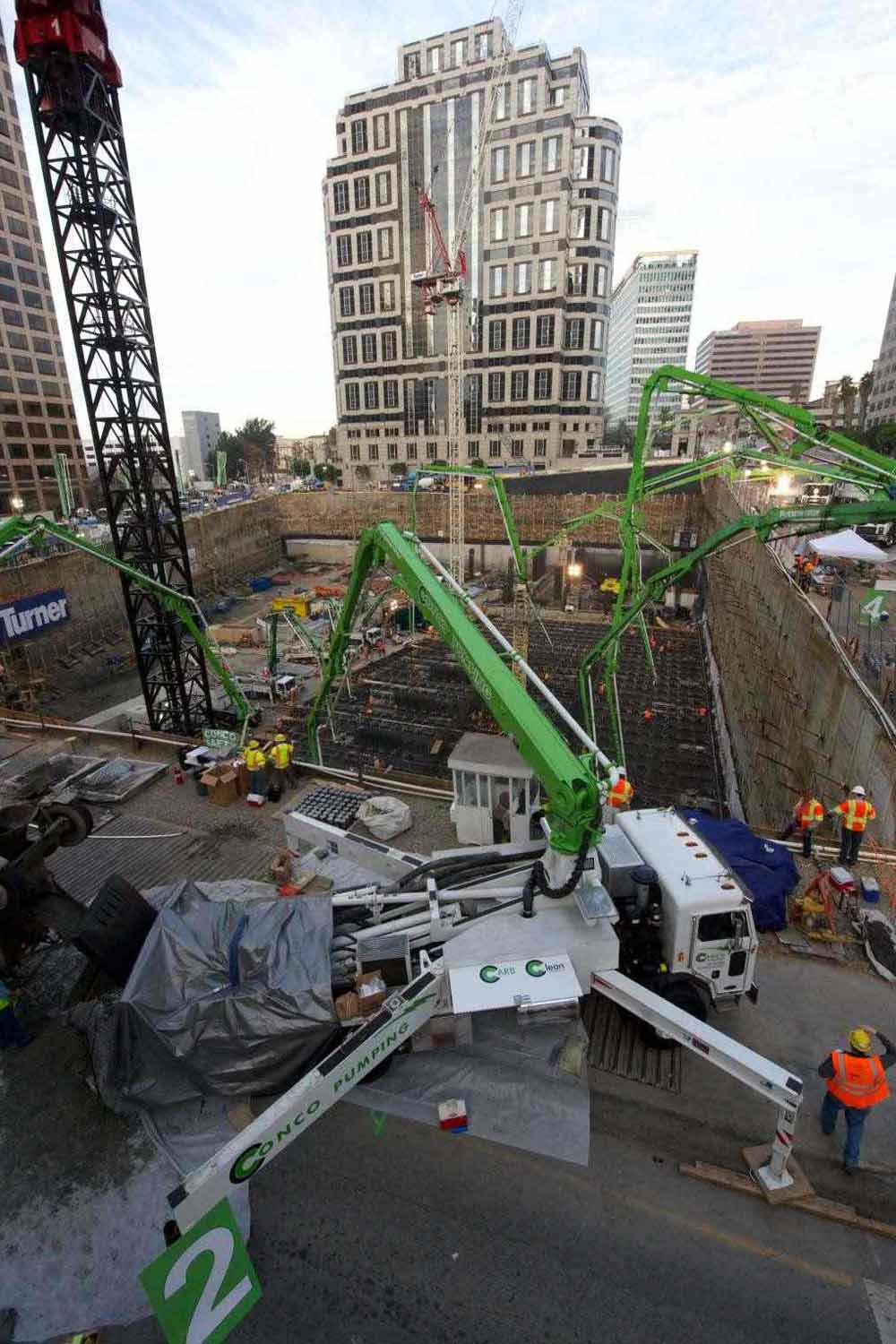
The February 2014 mat pour for Los Angeles’ Wilshire Grand project qualified as the largest continuous concrete pour in history and officially claimed a Guinness World Record. Credit Gary Leonard.
Upon completion in 2017, the new, 73-story Wilshire Grand project in downtown Los Angeles will be the tallest structure west of the Mississippi. Following deconstruction of the existing Wilshire Grand Hotel in 2013, construction of the new mixed-use building, designed by AC Martin Partners, Inc., commenced in February 2014 with the world’s largest continuous concrete pour. The project’s general contractor, Turner Construction Company (Turner), worked with The Conco Construction Companies (Conco), one of the largest pumping and belt companies in the U.S., to coordinate the fleet of pumps, including 16 Putzmeister America, Inc. (Putzmeister) units, required for the record-breaking, 21,200-cubic-yard (19,400 m³) mat pour.
Economic Impact
When Korean Air Lines Co., Ltd. (Korean Air) purchased the Wilshire Grand in 1989, the company recognized the need for world-class accommodations in Los Angeles, and planned to eventually create that true luxury flagship hotel in the internationally traveled city. As the largest Asian provider of air service to Los Angeles, Korean Air has had a significant impact on the region’s economy for decades. The Wilshire Grand project will continue that support by infusing more than $1 billion into the local economy. It will create more than 11,500 construction jobs and generate more than $80 million in tax revenue through the construction phase alone.
Comprised of 900 four-star hotel rooms, world-class restaurants, retail space, and 400,000 square feet (1219 m2) of new Class ‘A’ office space, once complete, the new Wilshire Grand will support nearly 2,000 new permanent jobs and contribute $16 million in annual local tax revenue. The project will play a critical role in the city’s commitment to add 5,000 new hotel rooms citywide—contributing to 20 percent of that goal.
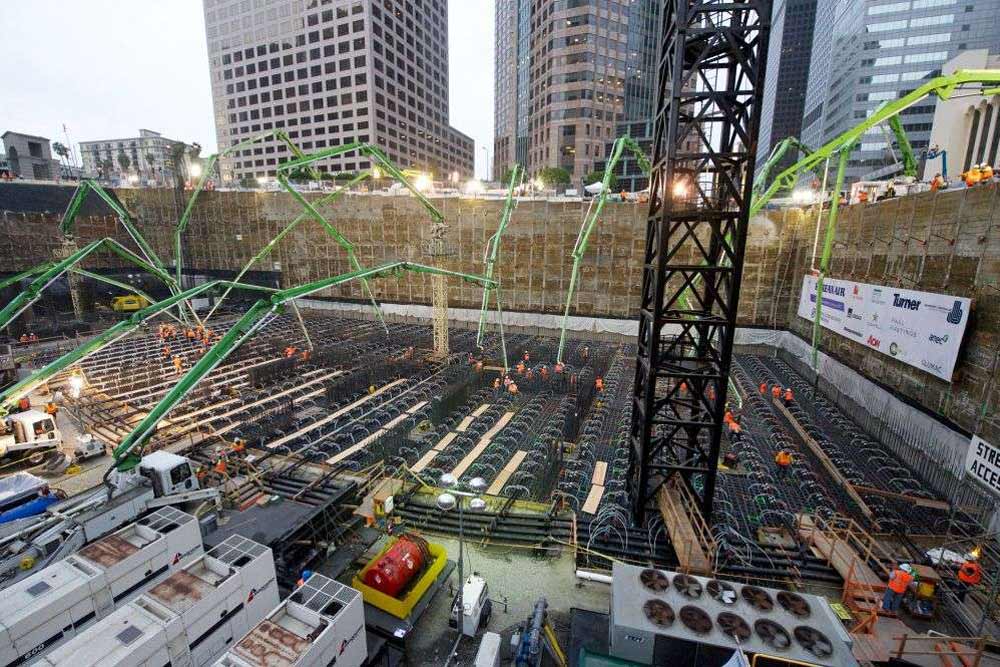
A fleet of 16 Putzmeister pumps were required for the record-breaking, 21,200-cubic-yard (19,400m3) mat pour. Credit Gary Leonard.
Record-Setting Pour
To lay the foundation for the massive Wilshire Grand project, Turner and Conco devised a plan for the continuous 21,200-cubic-yard mat pour, which was located 80-95 feet (24-29 m) below street level. For the past several months, crews have prepared the site by digging an 18-foot-deep pit and lining it with seven million pounds of reinforcing steel.
During the massive pour, 12 Putzmeister truck-mounted concrete boom pumps ranging from 32Z-47Z Meters, two Putzmeister placing boom towers, and two Putzmeister trailer-mounted concrete pumps were strategically placed both inside and above the excavation.
A total of 19 pumps were utilized for the pour. Six pumps at street level fed six pumps, including two Putzmeister MX 34/38Z Placing Boom Towers, two 32Z- and a 36Z-Meter Truck-Mounted Boom Pump, located deep in the excavation. Two Putzmeister BSA 14000 Trailer Pumps at ground level also relayed concrete into the pumps located inside the excavation.
“We utilized Putzmeister equipment due to its durability and reliability,” said Michael Marchesano, Turner’s general superintendent. “With a continuous pour of this magnitude, you need to be able to count on your equipment to keep doing its job, even under demanding conditions.”
The pour included 227 ready mix trucks making more than 2,100 trips and pouring 82 million pounds of concrete during an 18 ½-hour period.
“Each truck made 10 to 14 concrete drops, traveling through the night between eight different concrete plants within a 20-mile radius,” said Marchesano. “The first batch of concrete poured onto the site came from a plant in Vernon that poured the first concrete in Southern California ever.”
The structural engineering team, Brandow & Johnston, elected a continuous pour to ensure the mat foundation would yield the maximum strengths. To guarantee the entire pour cured at the same rate, a special 6,000 psi, 90-day mix was used. Special admixtures were used to ensure the temperature during the process of hydration didn't exceed the parameters designed for the mix. Without those admixtures the mat slab could have experienced thermal cracking and lower strength, which could impact the structural integrity of the pour. Following the pour, a cure blanket and a thermal control system were put into place for 15 days.
“We were extremely happy with how all of the Putzmeister equipment performed,” said Marchesano. “A pour this size requires extensive planning, precision, and dependable equipment. Everything went more smoothly than we could have imagined.”
The mat pour qualified as the largest continuous concrete pour in history and officially claimed a GUINNESS WORLD RECORD.
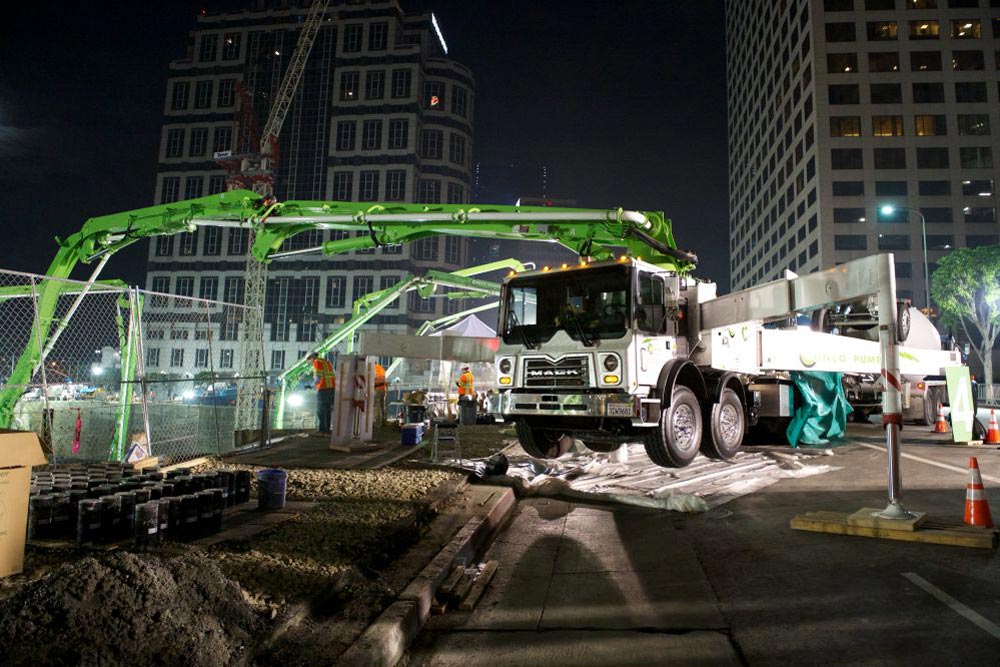
To minimize the impact on businesses and residents, the crew began the pour on a Saturday evening and concluded around noon the next day, working throughout the night. Credit Gary Leonard.
High-Traffic, Congested Location
Given that Los Angeles is the second most populous city in the United States, the construction team anticipated logistical challenges when planning the large mat pour at the project’s downtown location. To minimize the impact on businesses and residents, they began the pour on a Saturday evening and concluded around noon the next day.
“Because the concrete must be poured within 90 minutes of being mixed, trucks had to arrive on time,” Marchesano explained. “In case of freeway jams, alternate routes were mapped.”
Not only was outside traffic a concern, but job site congestion also was a challenge. Equipment had to be carefully chosen to accommodate the site’s needs.
“Through its durability and diverse selection of pumps, Putzmeister helped us overcome the challenge of having a large amount of material that needed to be poured continuously in a dense urban area,” said Marchesano. “Each piece of equipment had its role and was orchestrated to help make the pour run as smoothly and efficiently as possible.”
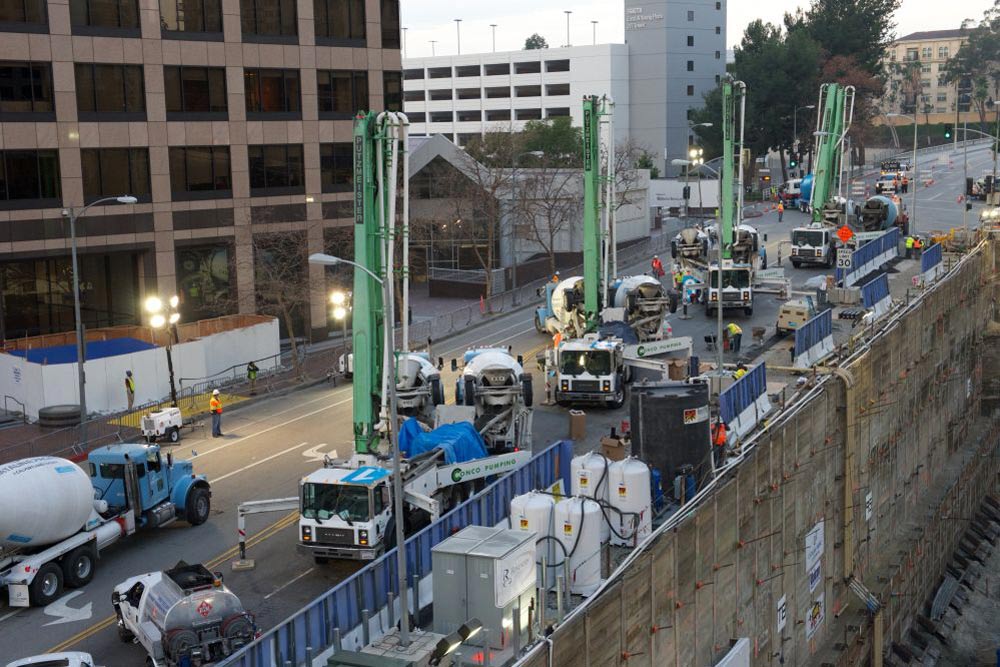
Six pumps at street level fed six pumps, including two Putzmeister MX 34/38Z Placing Boom Towers, two 32Z- and a 36Z-Meter Truck-Mounted Boom Pump, located deep in the excavation. Credit Gary Leonard.
Building Up
With the foundation in place, the crew has been working on the attached parking structure and 73-story building that will make up the Wilshire Grand project. Both of the existing Putzmeister MX 34/38Z Placing Boom Towers that were used for the mat pour have remained in place while the crew builds up. Two additional Putzmeister MX 34/38Z Placing Booms were constructed to help place concrete for the underground parking structure, and the two Putzmeister trailer pumps used on the mat pour have also remained on site to pump the concrete to the placing towers.
“We utilized Putzmeister equipment because of its proven durability and reliability,” said Doug Marquis, general manager at Conco. “With a high-profile job like this one, it’s essential to have the highest-quality equipment in place to minimize any potential for break downs and help keep the project on schedule.”
In total, the crew has pumped approximately 160,000 cubic yards (122,330 m2) of concrete vertically, including lightweight concrete and 8,000 psi mixes. A building of this height requires a pump that can maintain a balance between power and pressure to be able to deliver concrete floor after floor. The amount of friction that is generated during the pumping process as the concrete moves through the lines increases the higher the concrete is pumped. That friction has a significant impact on the plasticity of the concrete at the point of placement. Having the proper equipment helps minimize the amount of labor necessary on the deck to place and finish the concrete, allowing for a more aggressive schedule.
“The Putzmeister 14000 electric and diesel pumps performed flawlessly to push concrete over 1,165 horizontal and vertical feet,” said Michael Marchesano, Turner Construction’s general superintendent.
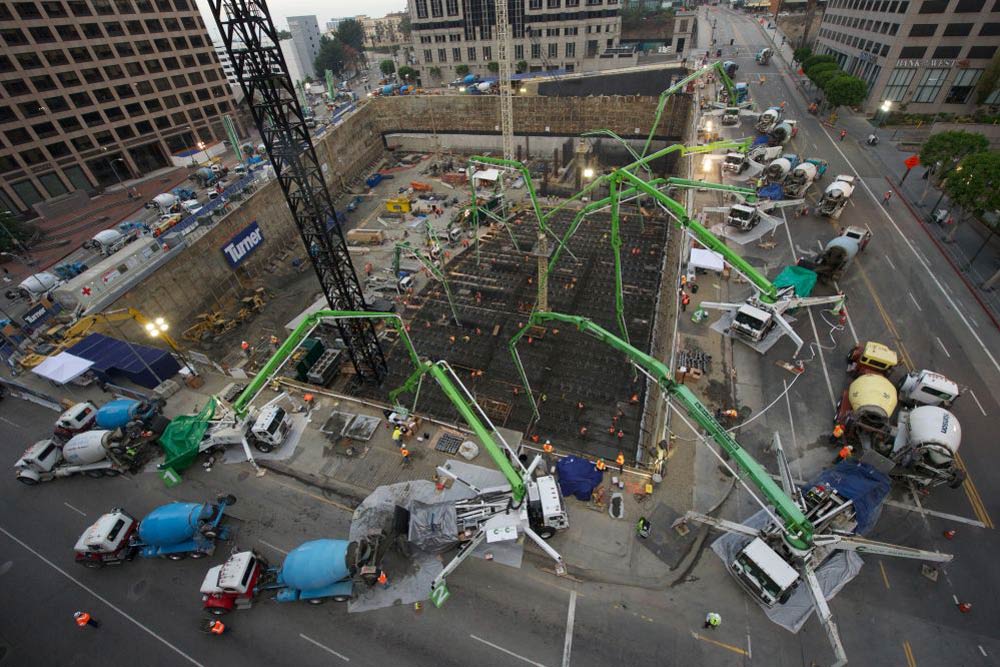
During the massive pour, 12 Putzmeister truck-mounted concrete boom pumps ranging from 32Z-47Z Meters, two Putzmeister placing boom towers, and two Putzmeister trailer-mounted concrete pumps were strategically placed both inside and above the excavation. Credit Gary Leonard.
Strategic Setup
Wilshire Grand is a podium-style high-rise, which means it has a “podium” or base section spread out at the foot of the building; from that base, the much taller tower is erected. After the base—the first few floors that comprise the retail and restaurant space—was poured, the setup consisted of one placing boom on the main tower, as well as three on top of the podium.
The two Putzmeister BSA 14000 Trailer Pumps worked in conjunction with the placing systems to deliver 90 percent of the concrete for the job. The setup allowed for multiple concrete placements to occur concurrently in order to meet the aggressive construction schedule. Additionally, a Putzmeister 36Z-Meter. Truck-Mounted Concrete Boom pump was used to place concrete on the lower levels of the structure, allowing for more flexibility in range.
Once the crews started working on the vertical placement for the tower of the structure, they utilized a single placing boom on a tower climbing system. The typical vertical concrete floor was placed on a four-day cycle, which included jumping the climbing system.
“This strategic setup was the result of project upfront planning by Turner Construction and Conco. These measures maximized the rewards of using the Putzmeister pumping equipment,” added Marchesano. “Every detail was measured, including redundancy pump station location, system sizing, and layout to enhance safety and avoid building sequence delays.”
Future Impact
As the largest Asian provider of air service to Los Angeles, Korean Air has had a significant impact on the region’s economy for decades. In 1989, the company purchased the original Wilshire Grand building because it recognized the need for world-class accommodations in Los Angeles, and planned to eventually create that true luxury flagship hotel in the internationally traveled city. The Wilshire Grand project will continue Korean Air’s investment in Los Angeles by infusing more than $1 billion into the local economy.
The Wilshire Grand Center will not only boast luxury hotel rooms, but also cutting edge restaurants, businesses and attractive nightlife offerings. The project will play a critical role in the city’s commitment to add 5,000 new hotel rooms citywide—contributing to 20 percent of that goal.
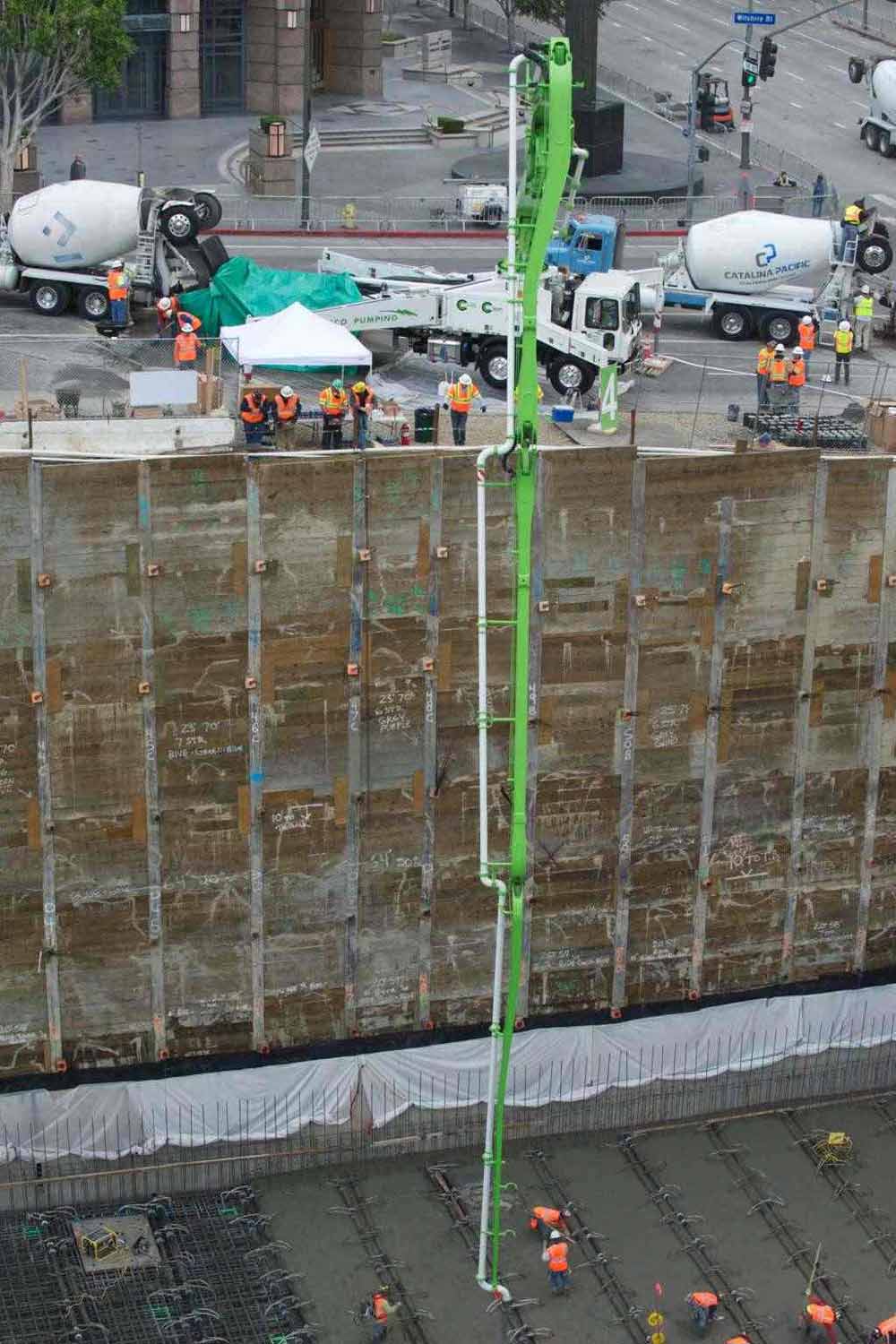
Pumps from above the excavation placed concrete into the 18-foot-deep pit, which was lined with seven million pounds of reinforcing steel. Credit Gary Leonard.
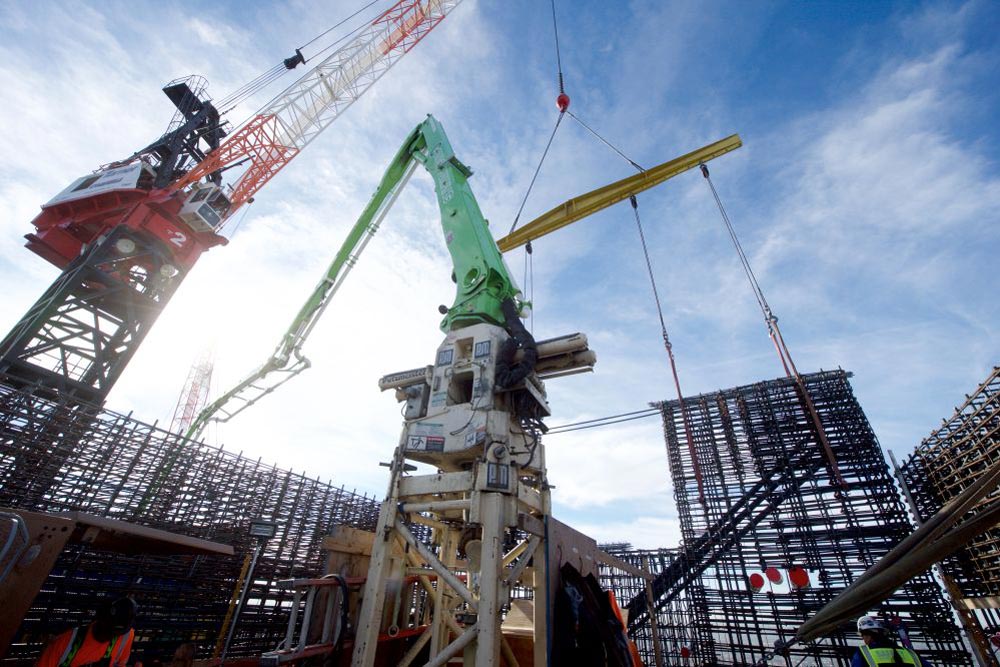
The typical vertical concrete floor was on a four-day cycle, which included jumping the climbing system. Credit Gary Leonard.
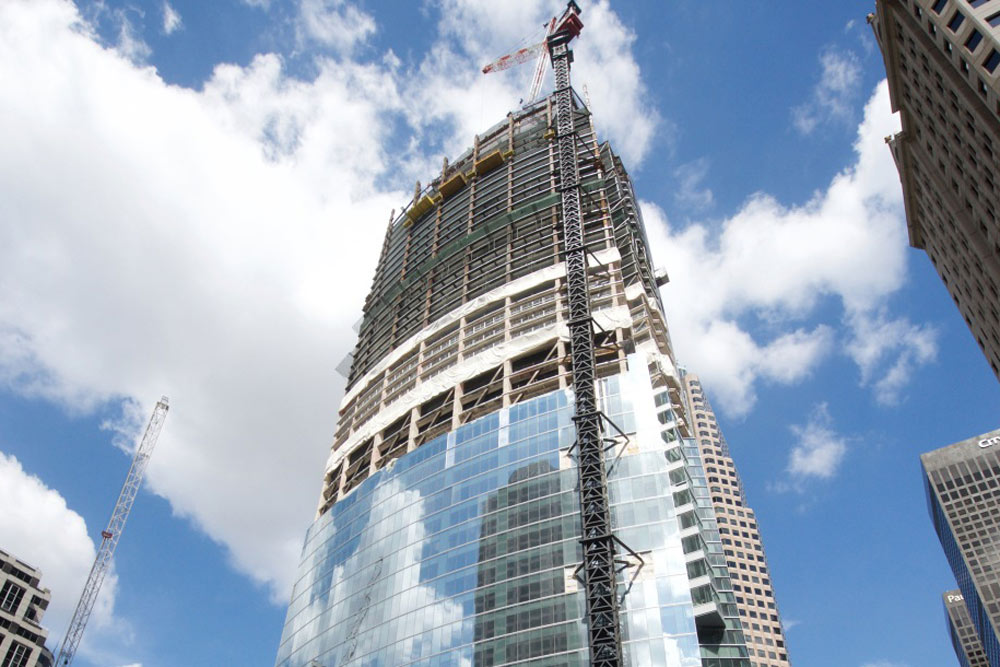
The new Wilshire Grand Center will offer luxury hotel rooms, cutting edge restaurants, businesses, and attractive nightlife offerings. Credit Gary Leonard.